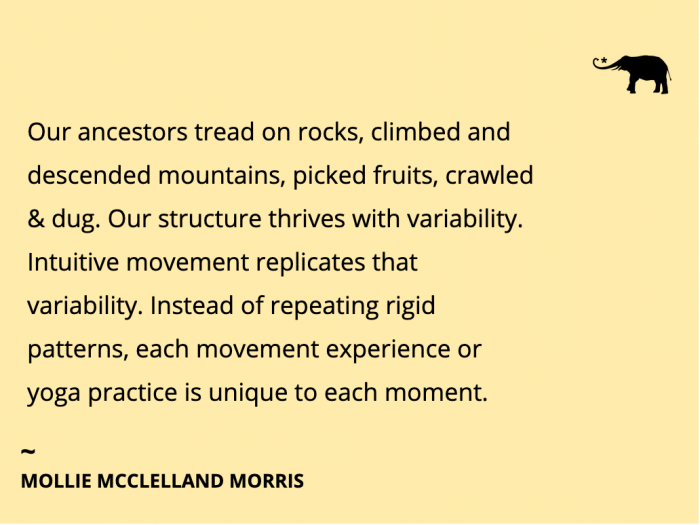With more yoga practitioners than ever, we are slowly finding the long-term effects of yoga practice on different bodies, which may have both positive and negative aspects.
Yogis get stronger, more flexible, and more aware of our bodies. At the same time, some get injured and need to reconsider why and how they practice yoga.
Functional movement, mindful strengthening, and various cross-training as well as what I call “intuitive movement” are increasing in popularity. They are filtering into and dovetailing with mainstream yoga, inspired by great teachers, advancements in exercise science, and other somatic disciplines.
These practices can feel unusual or intimidating to practitioners of more rigid yoga styles. But free movement has many benefits for yoga practitioners, whether used as part of a warm-up, yoga sequence, or within other daily movement practices.
What is “intuitive movement”?
Intuitive movement is not a specific term (or trademark I hope!), but something I use to describe movements with a clear reasoning behind them, but without a rigid set of parameters. For example, you wake up and stretch your arms, wiggle a bit to find a little peak, and then relax. Generally, that is the process to perform a pose, or activate a specific muscle. It is intuitive because the intention is subconscious but the purpose is to wake the body.
We do many types of intuitive movements, which, if done consciously, can contribute to our overall fitness, strength, mobility, flexibility, and general health.
How intuitive movement might fit into yoga:
Intuitive movement can be as simple as allowing a Cat/Cow series to move at its own pace. Or expanding the range in Cat/Cow beyond back and forth to circular movement. A next stage might be to play with spinal movements incorporating awareness of head and tail.
Some vinyasa practices include flowing sequences that are, by nature, intuitive, like moving back and forth from extended to reverse warrior. In this movement flow, you can’t be as “careful” about your alignment as in a static position. Exploring whether you “push” or “swing” through space can make the movement more intuitive.
Circular movements, focusing on individual joints, and pedaling the feet in Downward Dog are all examples of movement variations that can be intuitive. An important quality of these kinds of movements is attentiveness and care.
The benefits of intuitive movement:
For strength
Humans were not designed to do movements in predictable ways. Our ancestors did not walk on smooth floors or climb perfectly even stairs. They navigated rocks and roots, climbed and descended mountains and trees, picked fruits from branches, crawled, dug, and carried. Our structure can cope, and even thrive with variability. Intuitive movement replicates that variability. Instead of rigid patterns practiced daily, each movement experience or yoga practice is different.
Variability creates different challenges, so muscles develop strength in a dynamic way. Consistent practice of identical movements develops strength but in a single pathway. Many yogis get proficient at chaturanga, but struggle doing push-ups with wider arms. There is no reason to only work a single range; the shoulder joint benefits from strengthening many movement pathways.
For flexibility
For yogis who are naturally flexible, flexibility can hide stiff or immobile areas. In the spine, flexible areas can dominate movement so joints with less range are not required to move. In my body, a deep side bend that looks impressive activates more range of movement in my hip and hamstring, and barely moves the joints in my spine.
An intuitive practice of side bending (moving one hand down toward your knee, reaching up and over in different angles, circling from side bend toward diagonals or forward bend) will activate and challenge many more joints, with different loads and relationships to gravity. These movements have taught my spine to side bend, and at different joints or levels. Even if you also want to do a side bending pose, you’ll have more embodiment in the spine, revealing how you compensate and your true range of movement. Then you can focus or target a certain area in the pose by conscious choice.
Intuitive movement is great for creating mobility because, in general, we move the joints in a more three-dimensional fashion. Instead of reinforcing habitual patterns that might avoid our own stiff places, we encounter them and can play and explore into them. Contemporary research suggests that this type of movement eventually creates better range of movement and prevents injuries, than static stretching.
For enjoyment
A key benefit of intuitive movement is how good it feels. With a spirit of discovery and curiosity, rather than trying to fix yourself, you can play with images, speeds, qualities, and challenges. Even in a set yoga series, playing with your transitions, slowing down or speeding up, or adding new movements to your warm-ups can be more intuitive.
An Ashtangi friend told me every so often she “danced” through her practice. Her intuitive practice was letting go of strict breathing to move through the series in a long single flow.
How to start intuitive movement:
Start with something simple like Cat/Cow. Is there a way you always do this movement?
What else could you do? Think about speed, movement pattern, movement initiation.
Play and explore for as long as it is interesting. Then try something else.
The feel of dancing through or playing with your practice can help you start to move intuitively. You don’t have to let go of yoga poses altogether, but finding alternative ways in can make your practice dynamic for the longer term, and super enjoyable too.
~











Read 5 comments and reply